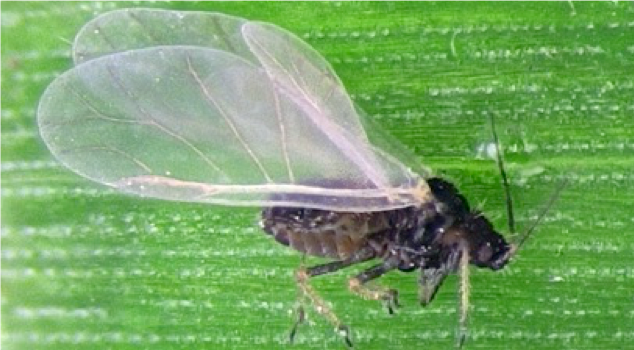The hedgehog grain aphid, which has caused millions of dollars worth of damage in other states, has been intercepted at Florida’s agricultural stations but not in the wild.
UF, Partners Asking for Help Identifying Them
When most people think of invasive species, first things that come to mind are pythons and Brazilian pepper.
The Florida First Detector program is taking a different track – focusing on insects as invasive species, particularly those with the potential to create damage in agricultural operations and natural areas. “No other state intercepts as many potentially invasive insects as Florida,” said
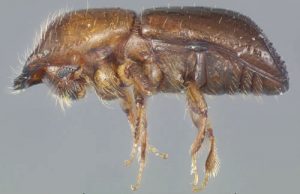
Amanda Hodges, director of the Doctor of Plant Medicine program at the University of Florida and a specialist in invasive species.
The first step in controlling the bad guys is reaching out to first detectors – the farmers and gardeners in the field who are most likely to see invasive pests first – with a series of workshops, including one held recently at the Keep Tampa Bay Beautiful demonstration garden at the Florida State Fairgrounds.
From there, the single most important issue is identifying pests and pathogens, particularly new pests that haven’t had a chance to become naturalized in Florida, Hodges said.
“Not all insects are bad – many are beneficial,” she said. The biggest problem with invasive species is that they don’t have natural predators, so they can quickly overtake native insect populations.
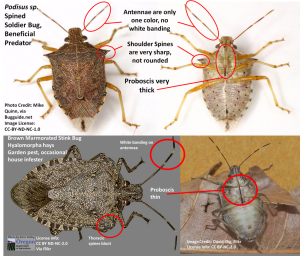
Graphic courtesy www.askanentomologist.com
The difference between some native pests and invasive exotics may only be visible only with a loupe or magnifying glass. The marmorated stinkbug, for instance, is differentiated from native pests because it has alternating bands of black and white on its legs.
“So far, it’s been intercepted at our agricultural border stations but not seen otherwise,” she said. Both brown and green stinkbugs are native to Florida, so farmers and gardeners are accustomed to controlling them, but the marmorated stinkbug caused more than $37 million in damage to crops in the Mid-Atlantic when populations increased dramatically.
Correct identification is critical because there are native stinkbugs that eat the insects that are devouring your plants, Hodges said. “You need to look at the mouth – if it eats plants, it has a very long mouthpart. Beneficial stinkbugs have short, stout beaks more suited to eating insects with hard shells than sucking the juice out of plants.”
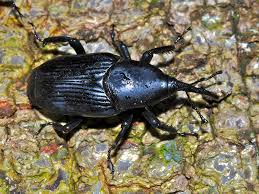
Another little-known but potentially damaging invasive highlighted at the Tampa workshop is the hedgehog grain aphid, an invasive grass-feeding aphid native to Europe (shown at the top of the article). First discovered in California in 2007, it’s been intercepted at Florida inspection stations as winged adults on lettuce from California and has been documented in multiple states in between. Sometimes known as the “black aphid” of its coloring, it also transmits barley yellow dwarf virus, a highly destructive disease in grain crops across the country.
Rather than spraying pesticides, UF and its partners are teaching Integrated Pest Management – or IPM – which relies upon prevention and monitoring, not toxic chemicals. Another important factor is changing environmental issues so that pests are less likely to be successful. For instance, eliminating monocultures like acres and acres planted in a single species is important. For insects like spider mites, increasing humidity can slow down growth rates.
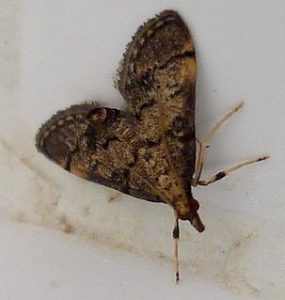
Participants also received a laminated guide to invasive pests covering newsworthy pests – citrus greening and giant African snails. Another important disease is the redbay ambrosia beetle and its symbiotic fungus Raffaelea lauricola which has killed over 30 million laurel trees in the U.S. and is threatening the state’s $65 million avocado crop.
“Florida gets 2.5 new insects every month,” Hodges said. “Some are good, some are bad, and some are harmless but we need people in the field reporting them as early as possible.”
Florida First Detector is a multi-agency effort to control invasive insects that brings together experts from the state and federal departments of agriculture and the University of Florida as well as organizations created specifically for that purpose. Hillsborough County Extension is planning another local event later this year; or learn more (including scripted presentations) at www.firstdetector.org.
[su_divider top=”no” text=”Learn More:” divider_color=”#087f43″ margin=”25″]
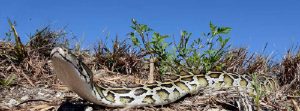
Beyond Bugs
New rules written to prevent invasive fish, birds, reptiles, amphibians and mammals from naturalizing in Florida went into effect May 2.
The regulations, approved by the Florida Fish and Wildlife Conservation Commission (FWC) in February, add high-risk non-native animals to the list of prohibited species as more clearly define some terms.
Species include:
* Mammals: meerkat/mongoose, raccoon dog, dhole, brushtail possum, flying fox.
* Birds: red-whiskered bul-bul, dioch, Java sparrow, pink starling.
* Reptiles: brown tree snake, yellow anaconda, Beni anaconda, DeSchauensee’s anaconda.
Prohibited species require that owners have permits for research or exhibition purposes, or prohibited species may be grandfathered in as pets with an FWC permit. People who currently own newly prohibited species as pets can turn them into the FWC’s Exotic Pet Amnesty Program if they don’t want to obtain a permit. They will be accepted without penalty and placed with pre-approved adopters.
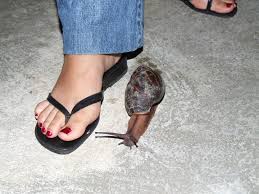
“Our native fish and wildlife are facing a serious threat posed by various invasive species found throughout the state,” said Kipp Frohlich, director of the FWC’s Division of Habitat and Species Conservation. “This new rule will help prevent those species on the prohibited list from becoming the next Burmese python.”
For more information about non-native species in Florida, visit www.MyFWC.com/Nonnatives.
To report invasive wildlife, call the FWC’s Exotic Species Hotline at 888-IveGot1 (888-483-4681 or use the free smartphone app IVEGOT1.
Interested? Check out more of our articles on invasive species!
